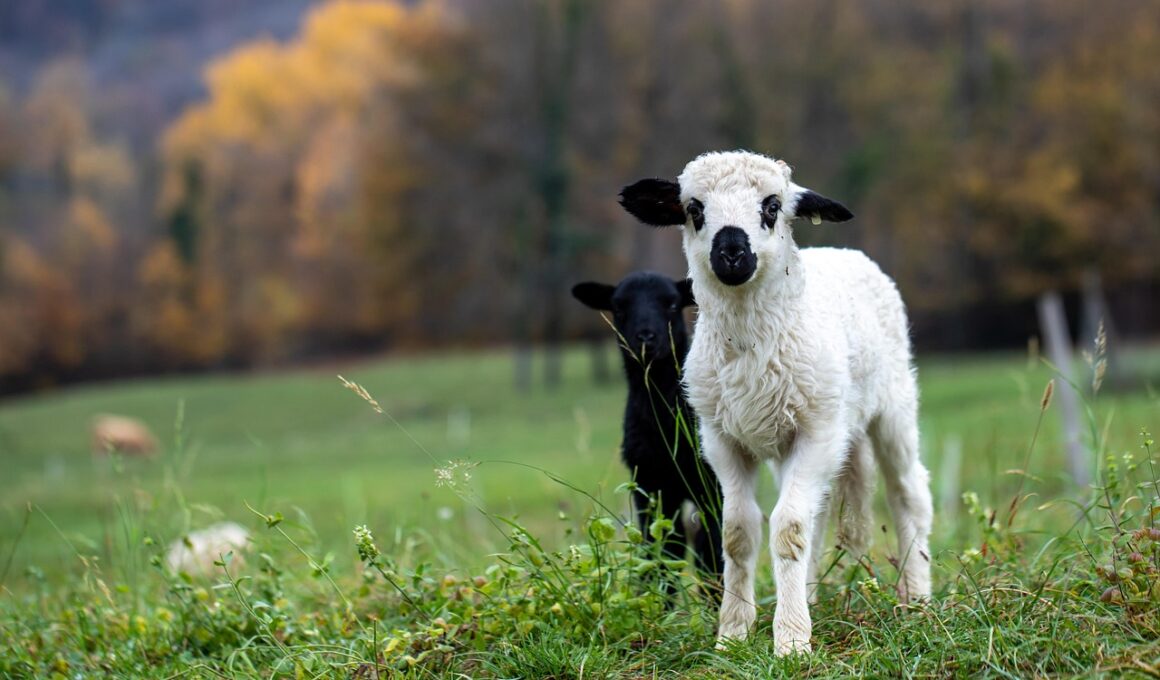Lamb as a Protein Source: Pros and Cons for Dogs
Lamb is increasingly being recognized as a viable protein source for dogs. This meat has unique nutritional properties beneficial to canine health. Lamb contains high levels of protein essential for muscle development and overall energy. Additionally, it is rich in vital nutrients, including vitamin B12, zinc, and iron. These nutrients contribute to various bodily functions, ensuring dogs maintain optimal health. Many dog owners select lamb as a protein alternative due to its excellent digestibility. This is especially true for dogs with food sensitivities. The distinct flavor of lamb can also entice picky eaters. Furthermore, lamb typically contains less fat than richer meats like beef, making it a preferable option for weight management. However, when transitioning to lamb, it is crucial to do so gradually. Long-term exposure to lamb can lead to allergies in some dogs. It’s always wise to consult a veterinarian before drastic dietary changes. Preparing lamb for canine consumption must ensure that it is cooked thoroughly, without harmful seasonings. This way, pet owners can provide their dogs with a safe, nutritious protein source.
One of the primary advantages of feeding lamb to dogs is its palatability. Many dogs find the taste of lamb appealing. This characteristic makes it an excellent choice for dogs that may be hesitant about their food. Dogs that experience allergies or sensitivities to poultry or beef can benefit greatly from lamb. Furthermore, lamb is less likely to trigger allergic reactions compared to these more common proteins. Given its abundant fat content, lamb should be introduced and served in moderation. For dog owners seeking to enhance their pet’s diet, lamb-based meals can be a welcome addition. Various commercial dog foods utilize lamb as a primary ingredient. When selecting lamb-based products, consider the sourcing and quality of meat used. Look for brands that prioritize high-quality protein sources without fillers or artificial additives. Additionally, many lamb offerings contain essential fatty acids promoting healthy skin and coat. This can mitigate skin irritations and enhance overall appearance. Remember to observe your dog’s reaction to lamb. Any sign of digestive distress may require a reevaluation of their diet. Consulting with a veterinarian is always recommended for personalized guidance.
Nutritional Profile of Lamb
Lamb is an excellent source of protein, packing approximately 25 grams per 100 grams serving. This high protein content is pivotal for active dogs requiring substantial energy levels. The amino acids present facilitate muscle growth and repair. Moreover, lamb’s zinc content plays a critical role in immune function. A robust immune response is essential for overall health, helping dogs fend off illnesses and infections. The presence of iron in lamb promotes healthy blood production. Copper, another mineral found in lamb, supports collagen synthesis and joint health. Lamb also contains vitamin B12, vital for neurological functions. This ensures dogs remain alert and active throughout their lives. Additionally, lamb offers a good balance of omega-3 and omega-6 fatty acids. These fats contribute to a shiny coat and healthy skin. However, careful attention to portion sizes is necessary to avoid unwanted weight gain, particularly in less active dogs. If feeding an entirely lamb-based diet, ensure it is balanced with other nutrients too. Always incorporate vegetables or supplements to fulfill all nutritional requirements. Monitoring overall health and body weight will help assess the diet’s effectiveness.
Despite its many benefits, there are some potential downsides to consider when incorporating lamb into a dog’s diet. One significant concern is the potential for fat content. Lamb can be richer in fat than other protein sources, such as chicken or fish. This high-fat content is beneficial for highly active dogs but may contribute to weight issues in less active or overweight pets. It’s crucial for dog owners to calculate the appropriate portion sizes to prevent excessive calorie intake. Allergies are another concern, as some dogs may develop sensitivities to lamb over time. If a dog exhibits skin irritations or digestive issues, consult a veterinarian. A dietary change might be necessary to ensure the dog remains healthy. Supplements may also be required to balance nutritional needs when feeding lamb. Owners should additionally be cautious about the origins of the lamb. Purchasing from reputable sources ensures the meat is free from harmful additives and contaminants. Whether choosing fresh or packaged lamb, quality control is essential. Always read labels and verify ingredient sourcing. Monitoring your dog’s response after introducing lamb will determine if it is a suitable protein source.
Cooking and Preparing Lamb for Dogs
Preparing lamb for dog consumption involves careful planning and execution. Always ensure the meat is fresh and sourced from reputable providers. Before cooking, trimming excess fat is vital for preventing gastrointestinal issues in dogs. When cooking lamb, it should always be thoroughly cooked to eliminate harmful bacteria. Avoid seasoning with spices or additives that could be toxic to dogs. Simple boiling or baking without any additional oils or spices works best. After cooking, let the meat cool adequately before serving. This prevents burns and ensures it’s safe for dogs to eat. Lamb can be shredded or chopped into bite-sized pieces to aid digestion. Additionally, blending lamb with vegetables can create a balanced meal, adding fiber and vitamins. Potatoes, carrots, and peas are good options to consider. Moreover, presenting lamb as a treat rather than a staple can also maintain the dog’s enthusiasm over time. Keeping portions manageable will help prevent overeating and ensure that dogs enjoy the flavor without overwhelming their digestive systems. Keeping track of how your dog feels after meals is crucial for ongoing dietary decisions.
When considering lamb as a protein source, variety is essential. Diversifying your dog’s protein intake is critical for balanced nutrition. While lamb is a noteworthy protein, it should not compose the sole source of nutrition for dogs. Combining lamb with other protein sources like chicken, fish, or even plant-based options can provide comprehensive nutrition. This variety will ensure that the dog receives a broad range of nutrients vital for their health. Grass-fed lamb, for example, may contain higher levels of beneficial omega-3 fatty acids compared to grain-fed alternatives. This difference highlights the importance of fodder and sourcing in pet diets. To keep meal times exciting, rotating different protein sources can help prevent food monotony. Engaging your dog with varied meal choices can minimize the likelihood of them developing food aversions. Ensure that any new proteins are introduced gradually to monitor for potential allergic reactions effectively. A balanced diet incorporating various protein sources benefits overall health, maintains energy levels, and ensures dogs enjoy their food. Integrating lamb thoughtfully into your dog’s diet can yield positive health outcomes.
Final Thoughts on Lamb for Dogs
In conclusion, lamb presents a wonderful option for pet owners considering high-quality protein sources for their dogs. With its distinct flavor and nutrient profile, lamb can significantly impact a dog’s diet positively. However, moderation and balance remain essential components of a successful feeding strategy. Regular monitoring of your dog’s health and dietary reactions is advisable. This vigilance can help affirm that lamb is a well-tolerated and beneficial protein source in their diet. Consult with a vet before making significant dietary changes to ensure effectiveness and safety. Furthermore, understanding the potential pros and cons associated with feeding lamb. This will enable dog owners to make informed decisions regarding their pet’s nutrition. Dogs that thrive on varied diets often exhibit better health and vitality. Lamb certainly holds a place within that framework of variety, providing essential nutrients for your dog’s well-being. By thoughtfully incorporating lamb, attention to sourcing, and preparing it correctly, pet owners can embrace this protein source confidently. In doing so, they rejoice in fostering healthier, happier companions through enriched diets, benefiting from the best meat options available.
This article serves as a comprehensive look at the inclusion of lamb in dog diets. By weighing the pros, cons, and preparation methods, owners can confidently select lamb as a suitable protein option.


